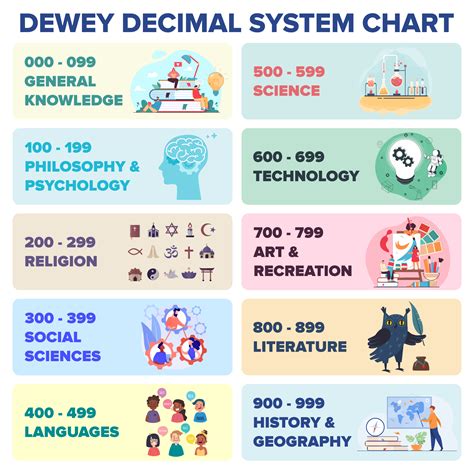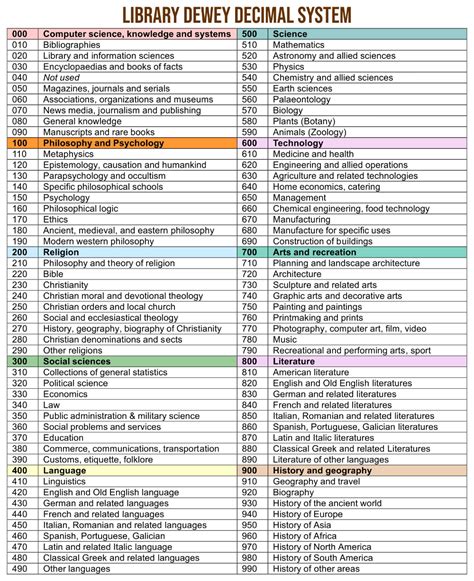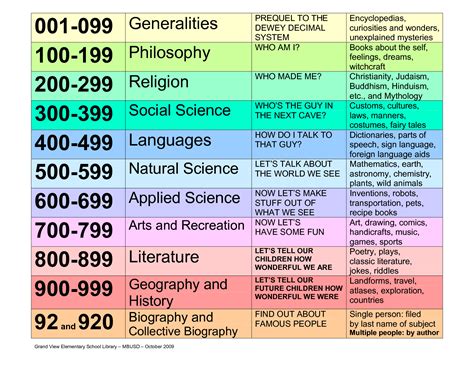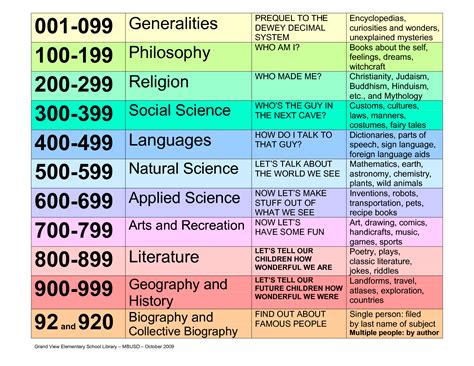The Dewey Decimal Classification (DDC) system is a widely used method for organizing and categorizing library materials. Developed by Melvil Dewey in 1876, the system has undergone numerous revisions to reflect the evolving nature of knowledge and information. The DDC system is used in over 200,000 libraries across more than 135 countries, making it one of the most widely used library classification systems in the world.
Overview of the Dewey Decimal Classification System

The DDC system is based on a numerical classification scheme, with ten main classes that cover a broad range of subjects. These classes are further divided into more specific subclasses, allowing for a high degree of granularity in the classification of materials. The system is designed to be flexible and adaptable, with new classes and subclasses being added as needed to reflect emerging fields of study and areas of interest.
Main Classes of the Dewey Decimal Classification System
The ten main classes of the DDC system are as follows:
- 000: General works
- 100: Philosophy and psychology
- 200: Religion
- 300: Social sciences
- 400: Language
- 500: Science
- 600: Technology
- 700: Arts and recreation
- 800: Literature
- 900: History and geography
| Class | Description |
|---|---|
| 000 | General works, including encyclopedias, dictionaries, and other reference materials |
| 100 | Philosophy and psychology, including metaphysics, ethics, and logic |
| 200 | Religion, including theology, religious history, and comparative religion |
| 300 | Social sciences, including sociology, anthropology, and economics |
| 400 | Language, including linguistics, language learning, and language teaching |
| 500 | Science, including physics, chemistry, biology, and mathematics |
| 600 | Technology, including engineering, computer science, and medicine |
| 700 | Arts and recreation, including music, art, and sports |
| 800 | Literature, including fiction, poetry, and drama |
| 900 | History and geography, including world history, local history, and geography |

Advantages and Limitations of the Dewey Decimal Classification System

The DDC system has several advantages, including its widespread use and acceptance, its flexibility and adaptability, and its ability to accommodate a wide range of subjects and materials. However, the system also has some limitations, including its reliance on a numerical classification scheme, which can be difficult to navigate for some users, and its potential for bias and cultural insensitivity.
Criticisms and Challenges of the Dewey Decimal Classification System
Despite its widespread use, the DDC system has faced several criticisms and challenges, including concerns about its cultural sensitivity and relevance to diverse user communities. Some critics argue that the system is too Western-centric and does not adequately reflect the perspectives and experiences of non-Western cultures. Others have raised concerns about the system’s potential for bias and its impact on the organization and accessibility of library materials.
Key Points
- The Dewey Decimal Classification system is a widely used method for organizing and categorizing library materials.
- The system is based on a numerical classification scheme, with ten main classes that cover a broad range of subjects.
- The system has several advantages, including its widespread use and acceptance, its flexibility and adaptability, and its ability to accommodate a wide range of subjects and materials.
- The system also has some limitations, including its reliance on a numerical classification scheme and its potential for bias and cultural insensitivity.
- Critics have raised concerns about the system's cultural sensitivity and relevance to diverse user communities, as well as its potential for bias and its impact on the organization and accessibility of library materials.
In conclusion, the Dewey Decimal Classification system is a powerful tool for organizing and categorizing library materials, but it requires careful consideration and expertise to use effectively. By understanding the main classes and subclasses of the system, librarians and researchers can ensure that materials are accurately classified and easily accessible to users. However, the system also has some limitations and challenges, including its potential for bias and cultural insensitivity, which must be addressed in order to ensure that library materials are organized and accessible in a way that is fair, equitable, and relevant to diverse user communities.
What is the Dewey Decimal Classification system?
+The Dewey Decimal Classification system is a widely used method for organizing and categorizing library materials. It is based on a numerical classification scheme, with ten main classes that cover a broad range of subjects.
What are the main classes of the Dewey Decimal Classification system?
+The ten main classes of the Dewey Decimal Classification system are: 000 (General works), 100 (Philosophy and psychology), 200 (Religion), 300 (Social sciences), 400 (Language), 500 (Science), 600 (Technology), 700 (Arts and recreation), 800 (Literature), and 900 (History and geography).
What are the advantages and limitations of the Dewey Decimal Classification system?
+The Dewey Decimal Classification system has several advantages, including its widespread use and acceptance, its flexibility and adaptability, and its ability to accommodate a wide range of subjects and materials. However, the system also has some limitations, including its reliance on a numerical classification scheme and its potential for bias and cultural insensitivity.
Related Terms:
- Dewey Decimal Classification PDF
- Dewey Decimal Classification online
- Dewey Decimal system lookup
- Dewey Decimal System Chart detailed
- Dewey Decimal Classification online free
- DDC Classification number
